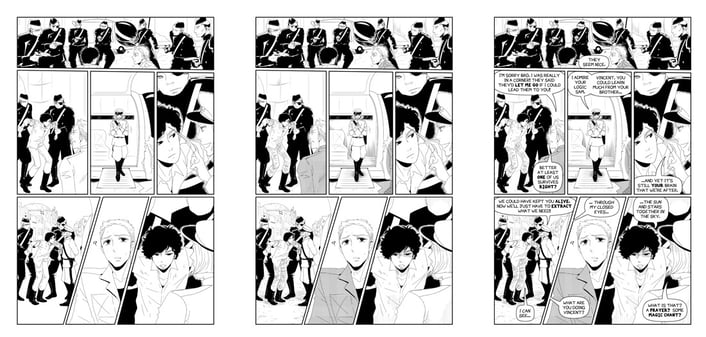 Our upcoming title How To Draw Manga: Made Easy is packed with helpful tips from a range of professional artists working in the industry. Today you can preview some of the expert advice on offer, with a quick look at basic page layouts.
Our upcoming title How To Draw Manga: Made Easy is packed with helpful tips from a range of professional artists working in the industry. Today you can preview some of the expert advice on offer, with a quick look at basic page layouts.
Making a Page in Collaboration
by Chie Kutsuwada
This is a page from Two Sons, a collaboration work with Richy K. Chandler, writer and letterer, and Inko, who did paneling and the rough sketches for this page. As you can see, three of us discussed the layouts in quite some detail at this stage.
Step 1
Think about the positions of the speech bubbles that create the pace of how the story goes. This page is done digitally and the program used is Clip Studio Paint.
Step 2
Here I draw more precise roughs. I use so many different layers, cut/copy and paste; move things around in order to get everything as right as possible. Take your time to adjust roughs. After working on one panel, do not forget to look at the whole page to see the balance as a page. When I draw human figures, I quite often draw a naked body first, then add its clothes on. It is useful, especially when the pose is complicated.

Step 3
Create a new layer and draw the panels. Then copy this layer and start inking on it. Start inking with the main figures, which control the balance of the each panels. Use the thicker line for the shadowy parts and thinner line for the detail, such as hairstreaks, sweat and creases.
Step 4
Add background and more detail. Usually I use a thinner and less pressure sensitive pen for the background. Always checking the balance of the page. For my personal preference, I do not think every panel should have background. However, at least one panel in a page should have a quite detailed background to show the whole situation of the story.

Step 5
Use the Paint Bucket tool and Select tool to paint black area. When the character’s costumes are black like this page, it might be a good idea to erase off some part around the edges/creases of the garments, such as the edge of collars in order to prevent the image becomes too heavy.
Step 6
Add shadows and tones. Using digital tones only might make the picture too stylized or hard, so I prefer adding some hand drawn lines for shadow and/or to give some textures. It maybe a good idea to do some exercises on drawing even parallel lines. Once you are accustomed to drawing steady even lines, this skill is adoptable for drawing hatching etc.
Step 7
The speech bubbles are added by the letterer and completed.

For much more information and advice on how to draw manga, make sure you pre-order our upcoming book How To Draw Manga: Made Easy. Full of expert advice, step by step images, and tonnes of helpful examples, this is the perfect title for anyone looking to hone their artistic skills.





